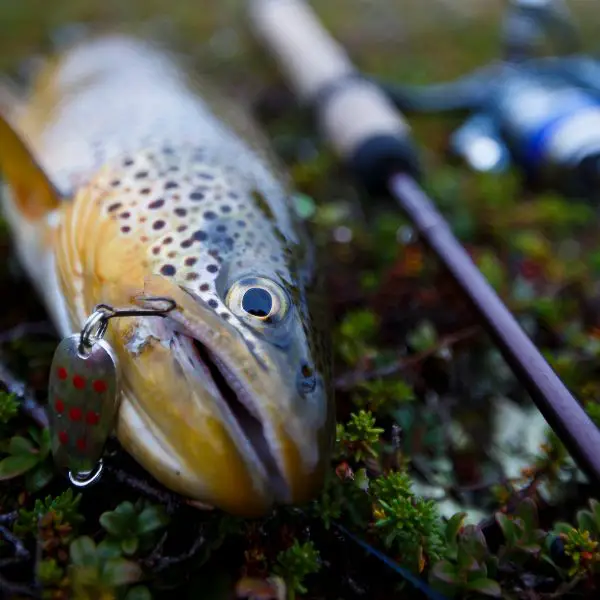How to catch trout with spoons
Spoons are among the oldest spinning lures still readily available, but they live in the shadows of flashy inline-spinners and lifelike jerkbaits such as the Rapala’s.
Spoons, in my opinion, are underrated, and many of us should fish them more. Spoons have some significant advantages over other lure designs. So, let’s not waste too much time on introductions and jump into why spoons are some of the best trout catching lures around.
Popular Spoons For Trout Fishing
Here is a quick summary of many popular spoons, scroll down to the bottom half of this article for more details on how to get the most out of many of these spoons.
| Spoon | Best for | Description |
|---|---|---|
| Thomas Buoyant | Best for Rivers | Excellent fluttering retrieve, slow sink rate, great for shallow ripples, excellent for streams |
| Acme Little Cleo | Best for Fishing Holes | Great for casting, heavier spoon for far casts and deeper waters, not suitable for smaller rivers. Fish enticing wobble, fast sink rate. |
| Acme Kastmaster | Best Casting Spoon | Best for distance, easy to cast, versatile design, durable, troll, cast or jig |
| Eppinger Daredevle | Best Trolling | Excellent for fishing deep, excellent trolling for lake trout |
| Mepps Little Wolf Spoon | Best Skinny Water Spoon | Small spoon, works well in skinny water and small streams. |
| Thomas Colorado Spoon | Excellent Small Streams Spoon | Great general-purpose spoon but excels in streams and shallow water. Comparable to Mepps little wolf. |
| Acme Phoebe | Excellent Shallow Water Spoon | Lightweight, great for fishing shallow water and ripples, curved design allows fishing at all speeds and depths. |
| Dreamweaver DW Spoon | Excellent Trolling Spoon. | Proven best trolling spoon, great action when trolled, not suitable for casting or strong currents |
| Luhr Jensen Krocodile | Excellent casting, Long-Body Spoon | Long, round chunky spoon, easy to cast, sinks quickly, great for searching for trout in big water. Works well when trolled. |
| Bluefox Moresilda Trout | Honorable Mention | Resembles tiny fish, casts like a bullet, sinks rapidly, good for fishing deep pools, fast currents, and trolling |
| Abu Garcia Toby | Rare Treasure | Casts well, fluttering retrieve, baitfish profile, hard to find |
| Super Duper | Honorable Mention | Bent boxy U-sharp design, traps water causing it to dance and wobble, controversial among anglers. |
When are spoons the best trout lure?
Spoons have several advantages over inline-spinners or jerkbaits. The two main advantages are ease of casting and the sink rate. But there is a lot more finesse to the details.
Most trout fishermen know this, but casting a tiny spinner or jerkbait can be challenging. For long distance casts, reach for a spoon. Spoons are typically made out of denser material and are more streamlined allowing for better aerodynamics.
So when fishing big rivers, lakes or simply targeting trout holding far away spoons are usually the best option. It is what I use when searching waters quickly I am not familiar with.
The second advantage, and maybe the most important advantage spoons have is sinking rate. They sink quickly. This makes spoons a great option for fishing close to the bottom, ideal for deep fast pools. This sink rate also makes them a popular lure for trolling in deep lakes and even for jigging.
So, when targeting trout holding in deep water. I usually will reach for a spoon. I honestly prefer to use a spinner or jerkbait when fishing in shallow waters, but in expert hands, a fluttering spoon such as the Thomas Bouyant is still an effective trout lure.
Reasons to fish a spoon over a spinner?
More trout are caught on inline spinners than any other style of trout lures, they are just that effective. So why would someone choose to fish a spoon?
Spinners are great, but their strength can also be their weakness. Spinners are loud, obnoxious lures. They vibrate through the water buzzing and sending flashes like it is a disco. They are loud and proud, and the trout know they are there.
Sometimes, all that light show is simply too much for trout, and rather than triggering them to strike. It triggers them to bolt to their nearest hide. Yes, spinners can spook wary trout. In these situations, the much less pronounced action of a spoon can actually prove to be more effective.
For a more detailed answer, and more analysis check my article on comparing spoons and spinners.
Fours rules when retrieving a spoon
Keep it slow.
Trout are not speedy predators, they are rarely prepared to chase prey down. Trout prefer to ambush, and pounce on their prey. Reeling in a spoon too slowly is usually much more effective than going too fast.
Vary your speed.
Baitfish, do not swim at a consistent speed. They dart and zig-zag around, often changing direction or even pausing for a few seconds before moving on again. try to replicate that swim style by varying the speed of your retrieve, put in short boosts of speed, and the occasional pause. I have found trout like to pounce on the pause.
Impact action.
Spoons often lack the fishlike actions of more modern designs, so it is a good idea to impact additional action during your retrieve by twitching your rod. This causes the spoon to swim erratically and might just trickier a following trout to strike.
Cast and wait.
After casting out, it can be a good idea to pause for a few seconds before starting your retrieve. Experience fishermen do this for several reasons. This gives the lure time to sink deeper towards the bottom where trout, especially steelheads and wary browns, often hold.
The next point is a bit of a gamble, and I will explain why. When a lure hits the water, it causes a splash, trout can respond in several ways. They can swim away in fright, they can ignore it, or they can zoom in to investigate. By delaying the retrieve, it gives wary trout a chance to forget the impact, and it gives curious trout a chance to swim over and explore what caused the splash. Now, if you cast right where the trout is feeding, they might strike straight away. In such situations, an immediate retrieve can work better.
How to fish a deep pool with a spoon
If there is one trout fishing scenario where spoons really shine, it is fishing deep, often fast water. Spoons, are made from chunkier denser material than spinners or minnows, which allows them to sinker faster.
This is ideal when fishing the bottom of pools, which is where many trout wait because it is out of the worst of the current, but they can easily swim up to intercept any prey being washed downstream.
When fishing a pool, I like to cast slightly upstream, maybe at a 3 o’clock direction. Then with minimal retrieve, I allow the spoon to drift down to the bottom. Pay attention, because it is possible to feel the spoon bouncing off rocks. Slowly, retrieve line to maintain contact and feel any strikes.
Once the spoon has drifted downstream slowly lift your rod tip and wind it back in before casting again.
Ideally, use the smallest spoon, which is dense enough to reach the bottom in a reasonable time. Some good options to use are Acme Little Cleo or, the Luhr-Jensen Krocodile
How to troll with a spoon Trolling is a massive topic within itself, with many different styles and techniques. Below I will give some key guidelines which will increase the chance of success.
Trolling for trout with Spoons
Troll Spoons Slow When Targeting Trout
Spoons are excellent trolling lures.
I see this mistake every time I troll on my local lake. People drive too quickly when they are trolling for trout. Trolling fast will catch the occasional trout and some other species but most trout will give up the chase if you are going too fast. For advice on how to troll slower check here.
I usually troll from my sit-on-top fishing kayak. When trolling I make a stroke every few seconds. I really just glide alone, barely causing a disturbance to the surface. I doubt I will be going much over 1 mile per hour. When not trolling, I paddle closer to 4-5mph. I have lost count, of the number of times I have been overtaken by boats trolling at much higher speeds.
In the chart below, I listed a rough trolling speed range for a variety of fish. It is a range because trout behavior does differ. When the water is very cold, or a bit too warm trout become sluggish and require even more time to strike. As a general rule, I try to troll no faster than 1mph.
If you want to maximize the number of species caught, it can be worth increasing the speed somewhat.
| Species | Trolling Speed Range | Trolling range kph |
| Lake trout | 1.0 to 3.0 mph | 1.5-4.5kph |
| Brown trout | 0.5 to 2.0mph | 0.7-3kph |
| Rainbow trout | 0.5 to 2.0 mph | 0.7-3kph |
| Brook trout | 0.5 to 2.0 mph | 0.7-3kph |
| Pike | 2.0 to 4.0 mph | 3.0-6.0kph |
| Bass | 2.0 to 4.0mph | 3.0-6.0kph |
| Walleye | 0.5 to 3 mph | 0.7-4.5kph |
| Tuna | 5.0-8.0mph | 9.0-14kph |
Use larger spoons to fish deeper.
Early in the season when the water is still cold, fish lighter, more bouyant spoons closer to the surface.
In the heat of summer, fish with denser, heavier spoons retrieved deeper in the water column.
If you get very serious, can also consider using additional weight or a down rigger to get the lures down even deeper.
Target structure
Trout, even in lakes often hold around structure. The kind of structure to look out for is submerged trees, river deltas, shallow flats, and weedbeds. The shoreline itself also provides many fishing opportunities.
Try trailing a light lure behind a heavy spoon.
Use a big heavy spoon such as a Daredevle, and on the bend of the hook tie a foot or so of monofilament. Then tie on a smaller, more finesse style of lure. A trout streamer such as a wooly bugger works extremely well.
The large spoon acts as a weight and does an amazing job at attracting fish in from a long distance. Trout being wary might choose to ignore the large spoon but still being opportunistic will grab at the much less risky small lure trailing behind.
10 of the best spoons for trout fishing
Best For Rivers: Thomas Buoyant
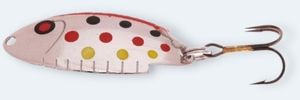
Another classic, the Tomas Buoyant sinks at a slower rate than most spoons.
This means more time fluttering through the water column and less time rubbing across the bottom.
It is a great spoon for fishing shallow waters such as streams or ripples.
The two cut-outs at the back of the lure results in an erratic wobble. Even at low retrieve speeds which is when most trout will strike. The slow retrieve wobbles makes it a great choice for early spring when the trout are still sluggish.
Best for fishing holes: Acme Little Cleo
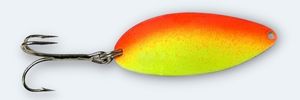
The little Cleo is a classic spoon. It sinks and get deep fast. This makes the Little Cleo an excellent option for fishing bigger rivers and deeper holes.
It is also a great option for getting through fast currents to the trout holding close to the bottom.
It is a very popular lure for targeting steelhead and salmon.
It will be my pick for fishing a deep pool in a swift flowing river.
Best Casting Spoon: Acme Kastmaster
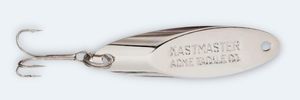
The ACME Kastmaster is not only an excellent spoon, but it is also one of the most popular trout lures in North America.
So what makes the Kastmaster such a great spoon? Well, it is such an easy lure to fish with. Firstly the design makes casting a breeze.
Anyone who can cast will cast a good distance on a Kastmaster. They just glide through the air with minimal resistance.
Their ease of use does not stop in the air, the moment the lure hits the water it starts to wobble. Even on the drop, giving off glimmers of light.
The Kastmaster does not care about retrieval speeds, retrieve fast and it darts forward like a fleeing baitfish, or retrieve slow, which is more effective for trout and it wobbles as it swims through the water.
When targeting trout, go small. The smaller the better. Trout are less likely to strike a large size kastmaster.
If I have one complaint, the Kastmaster is a bit boring. It lacks a x-factor or trigger that will dis-interested fished excited.
Check here for information regarding the best color kastmaster to catch trout.
Best trolling: Eppinger Daredevle
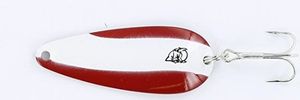
The Eppinger Daredevle has been catching trout for over 100 years.
Even today, it remains one of the most popular lures for targeting Lake Trout.
The Daredevle is more than just a trolling lure. It is also extremely effective fishing downstream in rivers.
Simply cast slightly upstream, and let it drop and flutter down with the current. It is one of my favorite lures for fishing deep pools and holes where I know the trout are holding tightly to the bottom.
Rare Treasure: Abu Garcia Toby
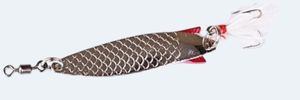
This long, skinny spoon was once the best selling spoon globally. Today it is nearly impossible to find in North America, although can still be brought in Europe and New Zealand.
The toby resembles a slim baitfish, the tiny rear wings help with buoyancy, allowing it to flutter and dance through the water on the retrieve.
Only the concave side of a Toby is painted, the reverse side is left plain and bright to give off flashes as we retrieve it through the water.
Toby’s casts nearly as well as Kastmaters, and are a great spoon for prospecting rivers or for trolling behind.
There are quite a few spoons with similar designs to the toby, such as the Thomas lures Speedy Shiner, and the Kenley Toby Wever.
Honorable Mentions
These spoons are worth a mention, but were not quite special enough, or too niche to make it into the top five.
6) Acme Phoebe
These little spoons somewhat resemble tiny fish. Being lightweight makes them a great for fishing shallow water, ripples typically found in streams. The curve design allows it to be fished at all speeds and depths.
7) Super Duper
The Super Duper looks a bit strange with its bent boxy U sharp design. The U-sharp bend, traps the water on the retrieve causing it to dance and wobble through the water. This spoon is quite controversial, same anglers absolutely love them while others are not even prepared to give it a try.
8) Luhr-Jensen Krocodile
the Krocodile is a long, round chunky spoon. It is easy to cast and for its length sinks quickly. I find the Krocodile a great lure for searching for trout in big water. It works well on a slow retrieve, or even with a jig action.
This spoon has quite a bit in common with the Abu Garcia Toby, but it sinks faster. Making it well suited for targeting trout holding near the bottom, especially in deep or fast flowing water.
9) Bluefox Moresilda Trout
These spoons resemble tiny fish. They cast like a bullet thanks to their solid construction. They sink rapidly, making them a good option for fishing deep pools or fast currents. They are also a very effective jigging lure and can be trolled.

